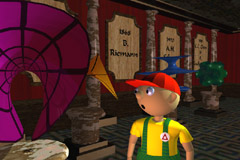|
|
Touching Soap Films |
|
|
|
History
Examples were rare in the 18th century. At first, only a single trivial and less interesting minimal surface was known: namely, the flat surface obtained when the boundary curve lies in a plane. The French geometer and engineer Jean Baptiste Meusnier (1754-1793) furnished the first non-trivial examples of minimal surfaces: the catenoid (Fig 9, also called the chain surface, because it is the surface swept out when one rotates the catenary curve that corresponds to a freely hanging chain about a suitable horizontal line) and the helicoid, or screw surface in Fig 10. The next example (cf. Fig 6) was first published in 1835 and was regarded as so sensational that its discoverer Heinrich Ferdinand Scherk (1798-1885), Professor at Kiel and Bremen, won a prize at the Jablonowski Society at Leipzig in 1831. The Belgian physicist Joseph Antoine Ferdinand Plateau (1801-1883), a Professor at Ghent, carried out extensive experiments with soap films in the mid-nineteenth century. Data from his accurate measurements of many surfaces served later as verification of theoretical results. Out of his investigations there developed the mathematically important conjecture that every closed boundary curve that neither touches itself nor intersects itself can be spanned by a minimal surface. The problem of finding this surface for a given boundary curve entered mathematical history as the "Plateau problem". Complete mathematical proof of its solvability-and therewith a partial answer to the question of Lagrange-was furnished first in 1931 by the American Jesse Douglas (1897-1965) and by the Hungarian Tibor Rado (1895-1965), independently of one another, using completely new mathematical tools. Their result marked a brilliant high point in the calculus of variations, a mathematical discipline whose development for more than 200 years has been tightly bound up with work on the question of Lagrange. In 1936 Douglas obtained the Fields medal for his work, the highest distinction awarded by the International Mathematical Union. As has happened so frequently in the history of mathematics, the solution of this long open problem immediately generated new questions. The theorem proved by Douglas and Rado proved only the mathematical existence of a minimal surface for a given boundary curve, but said very little about its geometrical properties. Further development concentrated therefore on a better understanding of this solution of the Plateau problem, in particular its behavior close to the boundary curve. In the last thirty years, interest has concentrated on a class of minimal surfaces that are conceptually far away from the original meaning of the term minimal surfaces: surfaces with no boundary curve - that is, they are infinitely extended. Because there were no sufficiently complicated examples for exact investigation, this new development proceeded only slowly. |
